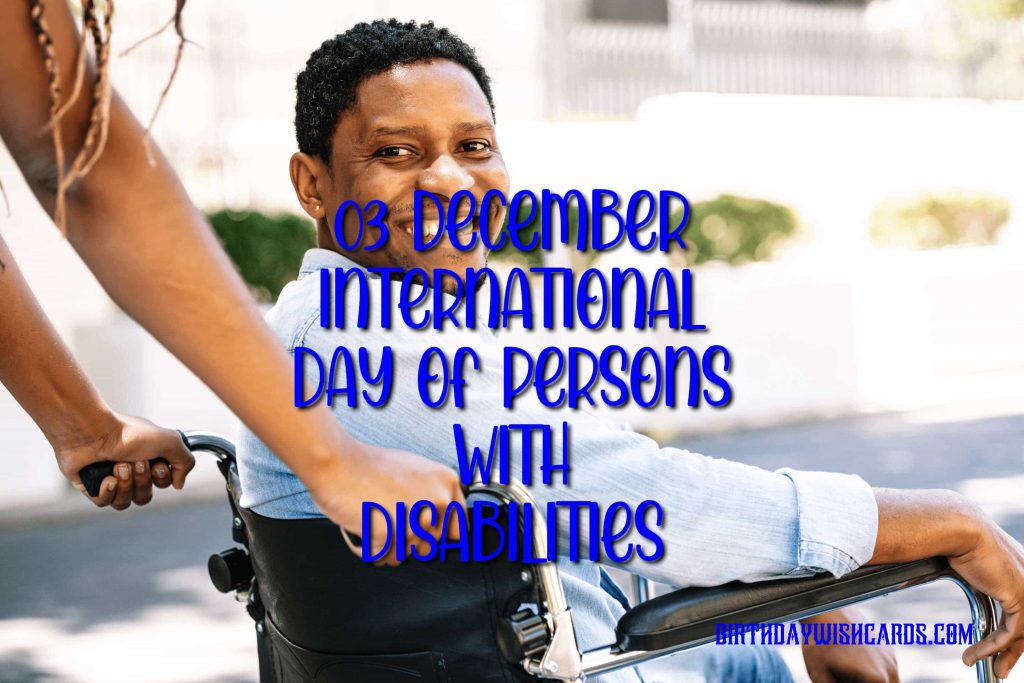
International Day of Persons with Disabilities
The International Day of Persons with Disabilities is observed annually to promote the rights and well-being of people with disabilities in every aspect of society and development. Established in 1992 by the United Nations General Assembly resolution 47/3, this day raises awareness of the challenges faced by persons with disabilities in political, social, economic, and cultural life worldwide.
Building on decades of United Nations advocacy, the Convention on the Rights of Persons with Disabilities (CRPD) was adopted in 2006. This landmark treaty has significantly advanced the protection and empowerment of people with disabilities, supporting the implementation of the 2030 Agenda for Sustainable Development and other global frameworks, such as the Sendai Framework for Disaster Risk Reduction, the Charter on Inclusion of Persons with Disabilities in Humanitarian Action, the New Urban Agenda, and the Addis Ababa Action Agenda on Financing for Development.
Understanding Disability
Disability refers to a condition or characteristic that significantly limits a person’s functioning compared to typical expectations within their community. The term encompasses a wide range of experiences, including:
- Physical impairments
- Sensory impairments
- Cognitive impairments
- Intellectual impairments
- Mental health conditions
- Chronic illnesses
While some definitions focus on a medical model—viewing disability primarily as a problem to be fixed—contemporary perspectives emphasize the interaction between individual impairments and societal barriers. This approach recognizes that disability is shaped not only by health conditions but also by environmental and attitudinal obstacles.
Challenges Faced by Persons with Disabilities
Persons with disabilities are often described as the world’s largest minority. They commonly experience:
- Poorer health outcomes
- Lower educational attainment
- Fewer economic opportunities
- Higher rates of poverty
These disparities are frequently the result of inaccessible services, such as information and communications technology (ICT), justice systems, and transportation. In addition, people with disabilities encounter various barriers in daily life, including:
- Physical obstacles in the built environment
- Legal or policy restrictions
- Negative social attitudes and discrimination
Heightened Risk of Violence
Persons with disabilities are at a significantly higher risk of experiencing violence compared to those without disabilities. Notable statistics include:
- Children with disabilities are nearly four times more likely to experience violence than their non-disabled peers.
- Adults with certain disabilities are 1.5 times more likely to be victims of violence.
- Adults with mental health conditions face nearly four times the risk of violence.
Factors contributing to this increased vulnerability include stigma, discrimination, lack of awareness, and insufficient social support for caregivers.
Promoting an Inclusive Society and Sustainable Development
Removing barriers and empowering persons with disabilities to participate fully in society benefits not only individuals, but also communities as a whole. When people with disabilities are excluded, society loses valuable contributions. Improving accessibility and inclusion is essential for achieving meaningful progress and sustainable development for everyone.
The Convention on the Rights of Persons with Disabilities recognizes that disability results from the interaction between individuals with impairments and attitudinal and environmental barriers. It defines disability as an evolving concept and emphasizes the importance of ensuring full and effective participation in society on an equal basis with others.
Accessibility and Inclusion as Fundamental Rights
Accessibility and inclusion are fundamental rights enshrined in the CRPD. They are not only goals in themselves but also prerequisites for the enjoyment of all other human rights. Article 9 of the Convention calls on States Parties to take appropriate measures to ensure that persons with disabilities can live independently and participate fully in all aspects of life and development.
The Convention mandates the removal of physical, legal, and social barriers, guaranteeing equal access to buildings, transportation, information and communication technologies, and essential services.
Visual Highlights of the International Day of Persons with Disabilities
How to Support Persons with Disabilities
Creating a more inclusive world requires collective action. Individuals, organizations, and governments can support persons with disabilities in the following ways:
- Advocate: Raise awareness of disability rights and challenge stigma and discrimination.
- Ensure Accessibility: Develop accessible infrastructure, provide accessible information, and implement inclusive policies.
- Promote Inclusive Education: Ensure educational opportunities that accommodate diverse learning needs.
- Foster Economic Empowerment: Create employment opportunities and support entrepreneurship among persons with disabilities.
- Strengthen Legal Protections: Enforce laws that protect against discrimination and violence.
- Provide Social Support: Offer services and support networks for persons with disabilities and their families.
The Global Impact of Disability Inclusion
Inclusive development benefits everyone. Societies that embrace diversity and ensure that no one is left behind are stronger, more innovative, and more resilient. The Sustainable Development Goals (SDGs) emphasize disability inclusion as essential for eradicating poverty, ensuring quality education, promoting decent work, and reducing inequalities.
To learn more about disability rights and international efforts, visit the United Nations Department of Economic and Social Affairs – Disability page and the World Health Organization’s Disability and Health section.
